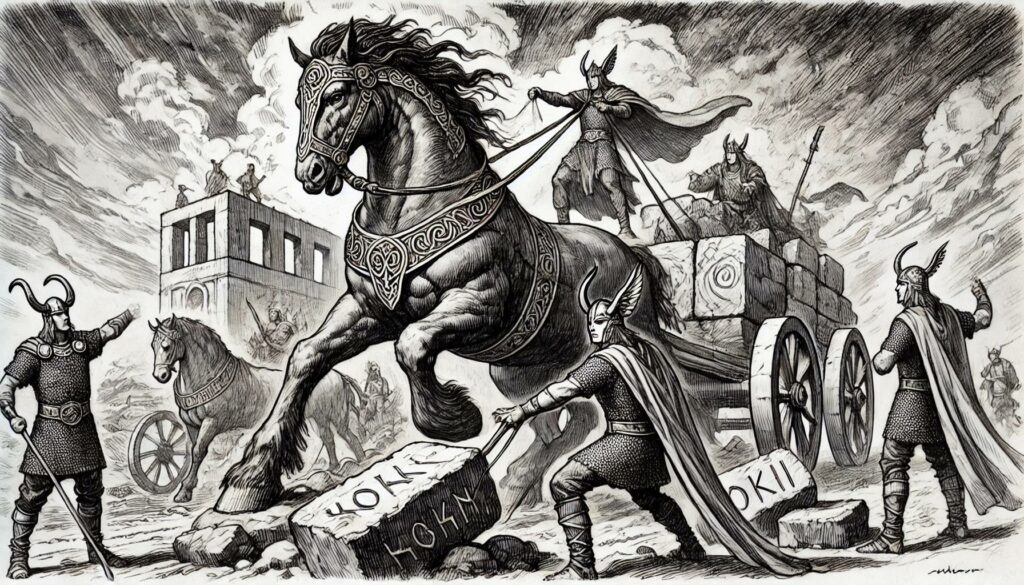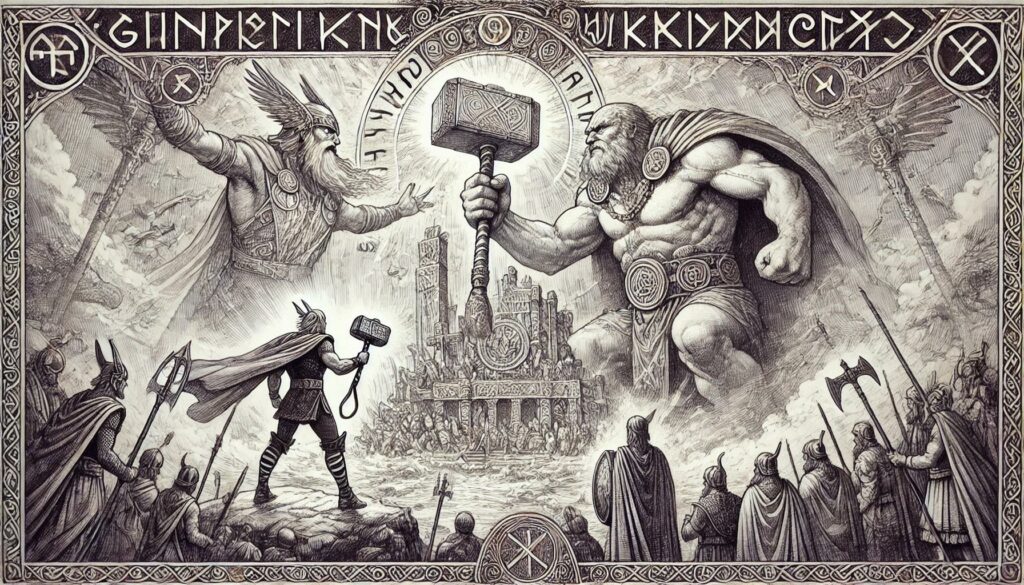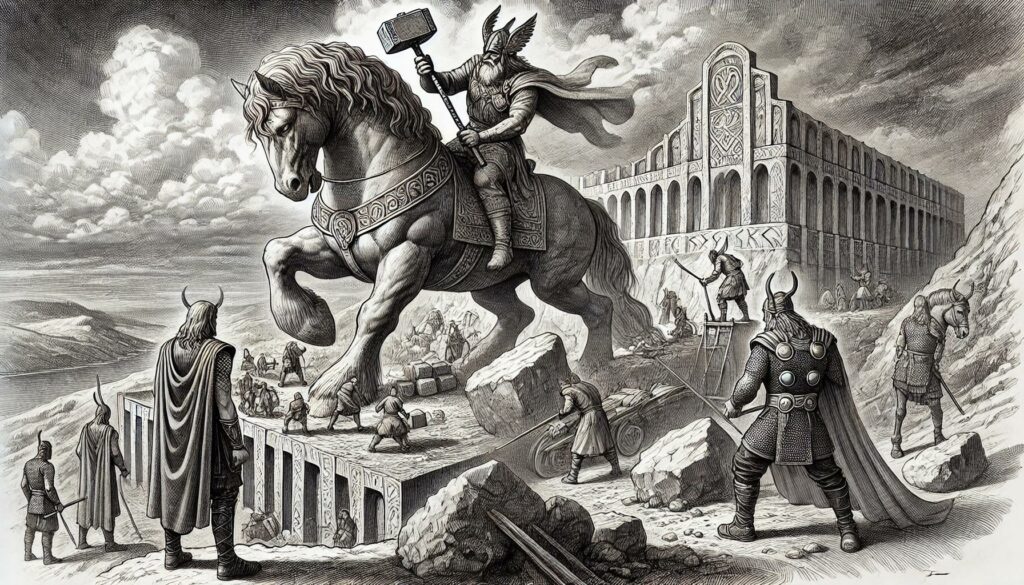Asgard’s fortified citadel in Norse mythology shows the Aesir gods’ might and cleverness. It was built to keep the gods safe from dangers from other worlds by forming a protective wall. The wall around Asgard was more than just a barrier. It symbolized the gods’ strength and watchfulness. The story brings us gods, giants, and mystical beings, painting a fascinating saga.
The Need for Asgard’s Fortification
The halls of Asgard were incredibly beautiful but also very open to danger. The Norse gods saw a big threat in giants. These giants wanted to invade Asgard, as told in Norse stories.
Odin, the leader of the gods, felt they had to protect their home. Asgard was full of powerful magic and needed protection. This was about more than walls; it was about facing big challenges like humans on Earth.
The gods and goddesses of Asgard worked together to build strong walls. Each stone they used was a sign of their hope. They wanted to make Asgard a place that no one could break into.
In Norse stories, building strong walls symbolizes fighting against darkness and chaos, particularly in old Norse traditions. Asgard’s defenses show this fight, staying strong against dangers.
The Arrival of the Giant Builder
In Asgard, a giant builder came without warning to build a fortification. He moved through time’s divine paths. This unknown giant’s visit became a crucial moment in Norse tales. He offered to build a wall protecting the gods for ages.
The gods pondered over his bold offer. He said he could finish in three seasons, creating a secure barrier around Asgard. He promised to finish the wall in time, ensuring the safety of the walls of Asgard. But he asked for the sun, moon, and Freya’s hand in return. This shook the heart of Asgard, sparking mixed emotions.
After a long debate, the gods agreed, knowing the risks. They were eager for protection yet troubled by the steep demand. So, a fateful and perilous agreement was made. It sets the stage for a complex story where destiny and luck play their parts in the construction of a protective wall.
The Role of Svadilfari
In the Norse tales, the great stallion Svadilfari shows incredible power and endurance. This magnificent horse helped build a wall around Asgard, the gods’ home. Its strength was so great that it did work that would have taken many men.
Every day, Svadilfari pulled huge stones. The journey was long, but the giant’s steed did not tire. The massive rocks were no match for Svadilfari’s determination to finish the wall.

The wall around Asgard took shape because of Svadilfari’s hard work. Both the stallion and its owner worked tirelessly to finish the wall in time. The gods were worried because the wall needed to be finished soon.
Svadilfari’s story weaves through the Norse legends. Its key role in building Asgard’s protection is remembered forever.
Loki’s Involvement and Deception
In ancient stories, Loki is a deceptive figure. He uses his crafty skills to help save Asgard and devises a clever plan to avoid a dangerous payment.
Loki changes into a mare to lure away Svadilfari, a giant’s stallion. His trickery disrupts important work. With grace and skill, Loki leads Svadilfari off, fooling everyone.
This scheme leads to a surprising event. The mare and stallion have a foal, adding a new chapter to Norse myth. Loki’s cleverness has lasting effects, showing the balance between wit and outcomes in divine stories.
The Turning Point of the Tale
The story reaches its peak as the summer’s first day breaks, marking a fateful deadline. The Norse gods, watchful and anxious, see the impending completion of the wall. Thanks to Svadilfari’s help, the strong builder gets closer to finishing the giant wall. This makes the gods even more worried.
In this tense time, Loki’s trickery shines. The god famous for his unpredictable plans comes up with a new way to stop the builder. He changes shape to distract Svadilfari. This move delays the wall’s completion.
Out of this bold move, something incredible happens. Loki’s action leads to the birth of Sleipnir, a horse with eight legs. This event is both amazing and seen as a message for a future event. It shows how far the gods will go to protect Asgard.
So, at this critical point in the story, a mix of cleverness and divine acts shows the Norse gods’ strength in building the wall. This story of intrigue and success is a great example of the Norse gods’ lasting power and creativity.
The Climactic Confrontation
The giant finally shows his true self, his anger obvious. It seems their peace deal is about to break. The gods of Asgard are ready for a big fight.

The giant is really mad, and his anger fills the halls, especially over the unkept oath. The gods know they must act quickly to ensure the walls of Asgard are completed. Thor steps up with his hammer, ready to defend Asgard.
This battle is about more than just winning. It shows how strong Asgard truly is with its formidable protective wall. Every punch is a fight for survival, a roar against their enemies.
Reflections and Themes in the Tale
The fortification of Asgard is a rich example from Norse mythology. It gives us deep insight into how the Norse viewed life and the universe. This story highlights the timelessness of Norse culture, focusing on trust, the fallout of deceit, and the power dynamics between gods and giants.
As we explore this myth, it becomes clear that it is not just a tale. It reflects the hopes, fears, and values of the Norse people. The Asgard story shows us the importance of trust and the ruin deceit can cause. It stresses the fragility of alliances.
The tale also makes us think about life and the constant quest for power and survival. Characters like Loki and the determined builder show us important aspects of human nature, especially in the context of keeping an oath. This story adds to the rich tapestry of Norse heritage and gives us ageless insights into life and its challenges.

